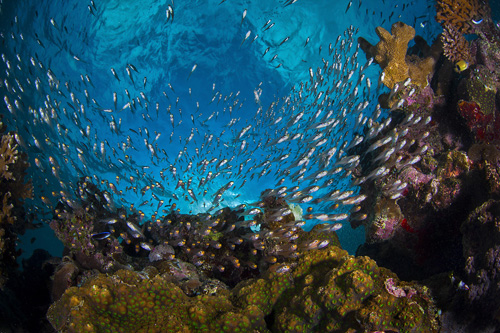Contact: Jeff Burgett, PICCC Science Coordinator 808-687-6149 Email: [email protected] Honolulu, Hawai’i.

Coral reefs are home to more than 25% of all known marine fish species. Photo: Glassy sweepers, Polynesia. Credit: Thomas Vignaud.
Honolulu, Hawai’i. February 18, 2014 – An international team of coral reef scientists has used the latest global climate models to reveal timelines for the accelerating decline of the world’s coral reefs through the end of the century. If global emissions of greenhouse gases keep rising at or near the current rate, “within 40 years, nearly all coral reefs globally will be subjected to stressful conditions so regularly that reefs are unlikely to persist as we know them,” says study co-lead Dr. Ruben van Hooidonk.
Dr. van Hooidonk and his co-lead Dr. Jeffrey Maynard developed interactive online maps of their study results, showing the timelines for when each coral reef area will experience critical levels of temperature stress and ocean acidification. The study is published in Global Change Biology in its January 2014 issue.
Coral reefs provide food and commercial fisheries, protect coastlines from waves, support tourism, and are inextricably interwoven into the cultural foundations for millions of people throughout the tropical oceans. Seychelles Ambassador for Climate Change and Small Island Developing State Issues, Ronald Jumeau noted that, "It is a common misconception that sea level rise is the greatest threat to small island countries, when in fact the decline of the coral reefs that help feed and protect us and contribute to our wealth and well-being is a more immediate threat to the economic viability and the very physical existence of many of our islands."
In the Pacific, island societies already are struggling with effects of global climate change on the habitability of their homelands. Coral reef decline will further affect the ability of these nations to navigate a changing future. Minister Tony DeBrum of the Republic of the Marshall Islands states, “Our islands and cultures have always been defined by our ability to interact with our marine and terrestrial environment. The impacts of climate change threaten the very existence of our unique identity as people and our sovereignty as a nation – a recognized member of the global community.”
Deanna Spooner of the Pacific Islands Climate Change Cooperative that provided funding for the research said, “This study makes complex information about climate change impacts on coral reefs available for the first time in an accessible format. Now, coral reef managers and other decision makers can see what the future likely holds for their region’s reefs and better communicate about the need for immediate conservation actions.”
This is another important scientific study that demonstrates the peril facing coral reefs today and into the future,” says Dr. Robert Richmond of the University of Hawai’i. “There is a clear urgency in responding to greenhouse gas emissions. Unless effective actions are undertaken at the global level, the future of coral reefs and those who depend on these incredible ecosystems is bleak.” Coral reef managers attempt to protect reefs and increase their resilience to stress by minimizing human impacts such as overfishing, polluted runoff, and invasive aquatic species. Strengthening these efforts through better land-use practices and the use of marine protected areas is also essential, Dr. Richmond stresses, “in order to buy time to address the ever-increasing problems caused by climate change.”
What the Study Reveals
Abnormally high ocean temperatures cause corals to “bleach” or lose the symbiotic algae that give them color and provide nutrients (food). Prolonged bleaching events can kill corals over large reef areas, and repopulation by corals, fish and other reef species may take a decade or more. As global warming proceeds, the temperature stress that causes bleaching is projected to become more severe and recur more often, eventually happening every year. It’s unlikely that most coral reefs can survive annual bleaching events. In addition, rising carbon dioxide concentrations will cause increasing ocean acidification, gradually reducing the ability of corals to form the stony skeletons that give reefs structure.
The study shows that the decade in which these stresses to reefs reach critical levels varies by latitude, and depends on rates of global greenhouse gas emissions. Annual bleaching is projected to occur sooner near the equator and later at higher latitudes. However, these high-latitude reefs will have more time to be exposed to ocean acidification. The online maps, hosted by NOAA’s Coral Reef Watch, use Google EarthTM and allow users to select emissions scenarios, coral sensitivity levels, and different levels of ocean acidification. Users can then see when climate models suggest stressful bleaching events will occur or when various levels of acidification will be reached.
This work was supported by the Pacific Islands Climate Change Cooperative and the U.S. Fish and Wildlife Service, with additional support from the NOAA Coral Reef Conservation Program.
The Google Earth tool can be accessed at this link:
http://coralreefwatch.noaa.gov/climate/projections/piccc_oa_and_bleaching/index.php
High resolution images can be accessed at this link:
http://piccc.net/coral-media-release.htm
Full citation for the Global Change Biology article: van Hooidonk, R., Maynard, J. A., Manzello, D. and Planes, S. (2014). Opposite latitudinal gradients in projected ocean acidification and bleaching impacts on coral reefs. Global Change Biology 20: 103–112. doi: 10.1111/gcb.12394
The Pacific Islands Climate Change Cooperative (PICCC) is a self-directed, non-regulatory conservation alliance whose purpose is to assist those who manage native species, island ecosystems and key cultural resources in adapting their management to climate change for the continuing benefit of the people of the Pacific Islands – http://piccc.net